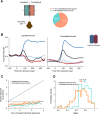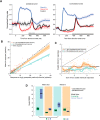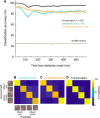A Normalization Circuit Underlying Coding of Spatial Attention in Primate Lateral Prefrontal Cortex
- PMID: 31001577
- PMCID: PMC6469883
- DOI: 10.1523/ENEURO.0301-18.2019
A Normalization Circuit Underlying Coding of Spatial Attention in Primate Lateral Prefrontal Cortex
Abstract
Lateral prefrontal cortex (LPFC) neurons signal the allocation of voluntary attention; however, the neural computations underlying this function remain unknown. To investigate this, we recorded from neuronal ensembles in the LPFC of two Macaca fascicularis performing a visuospatial attention task. LPFC neural responses to a single stimulus were normalized when additional stimuli/distracters appeared across the visual field and were well-characterized by an averaging computation. Deploying attention toward an individual stimulus surrounded by distracters shifted neural activity from an averaging regime toward a regime similar to that when the attended stimulus was presented in isolation (winner-take-all; WTA). However, attentional modulation is both qualitatively and quantitatively dependent on a neuron's visuospatial tuning. Our results show that during attentive vision, LPFC neuronal ensemble activity can be robustly read out by downstream areas to generate motor commands, and/or fed back into sensory areas to filter out distracter signals in favor of target signals.
Keywords: attention; macaque; neurophysiology; normalization; prefrontal cortex.
Figures











Similar articles
-
Encoding of Spatial Attention by Primate Prefrontal Cortex Neuronal Ensembles.eNeuro. 2018 Mar 21;5(1):ENEURO.0372-16.2017. doi: 10.1523/ENEURO.0372-16.2017. eCollection 2018 Jan-Feb. eNeuro. 2018. PMID: 29568798 Free PMC article.
-
Attentional filtering of visual information by neuronal ensembles in the primate lateral prefrontal cortex.Neuron. 2015 Jan 7;85(1):202-215. doi: 10.1016/j.neuron.2014.11.021. Epub 2014 Dec 11. Neuron. 2015. PMID: 25500502
-
Single-Trial Decoding of Visual Attention from Local Field Potentials in the Primate Lateral Prefrontal Cortex Is Frequency-Dependent.J Neurosci. 2015 Jun 17;35(24):9038-49. doi: 10.1523/JNEUROSCI.1041-15.2015. J Neurosci. 2015. PMID: 26085629 Free PMC article.
-
Single-trial decoding of intended eye movement goals from lateral prefrontal cortex neural ensembles.J Neurophysiol. 2016 Jan 1;115(1):486-99. doi: 10.1152/jn.00788.2015. Epub 2015 Nov 11. J Neurophysiol. 2016. PMID: 26561608 Free PMC article.
-
Effects of attention on visuomotor activity in the premotor and prefrontal cortex of a primate.Somatosens Mot Res. 1993;10(3):245-62. doi: 10.3109/08990229309028835. Somatosens Mot Res. 1993. PMID: 8237213
Cited by
-
Minimally dependent activity subspaces for working memory and motor preparation in the lateral prefrontal cortex.Elife. 2020 Sep 9;9:e58154. doi: 10.7554/eLife.58154. Elife. 2020. PMID: 32902383 Free PMC article.
-
After a period of forced abstinence, rats treated with the norepinephrine neurotoxin DSP-4 still exhibit preserved food-seeking behavior and prefrontal cortex fos-expressing neurons.Heliyon. 2024 Jun 4;10(13):e32146. doi: 10.1016/j.heliyon.2024.e32146. eCollection 2024 Jul 15. Heliyon. 2024. PMID: 39027623 Free PMC article.
-
Neural Substrates of Visual Perception and Working Memory: Two Sides of the Same Coin or Two Different Coins?Front Neural Circuits. 2021 Nov 26;15:764177. doi: 10.3389/fncir.2021.764177. eCollection 2021. Front Neural Circuits. 2021. PMID: 34899197 Free PMC article. Review.
References
Publication types
MeSH terms
LinkOut - more resources
Full Text Sources
